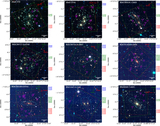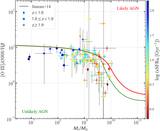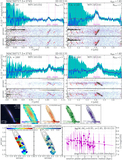Image Details

Caption: Figure 2.
The HST grism spectra for one exemplary object in our sample, MACS 0416–ID 00955, at z ∼ 2. The total on-target exposure time is equally split between two nearly orthogonal PAs (shown in the two subfigures), reaching five orbits of G102 and two orbits of G141 exposures per PA. In each subfigure, we show the optimally extracted 1D spectra and the full 2D spectra with and without source stellar continuum subtraction for both grism channels. The 1D observed Fλ flux and its 1σ uncertainty are represented by the blue solid lines and cyan shaded bands, respectively. The wavelengths of the nebular line emission features are marked by magenta vertical dotted lines and red arrows in 1D and 2D spectra, respectively. The red dashed curves show the 1D model spectra, combining both stellar continuum (given by spectral template synthesis) and nebular line emission (modeled as Gaussian profiles), after the source morphological broadening is already taken into account. We emphasize that the same best-fit spectral model is used for each individual source, yet the differences in continuum shape and flux levels at the two PAs are originating from the varying source morphological kernels along the two light dispersion directions.
Copyright and Terms & Conditions
© 2020. The American Astronomical Society. All rights reserved.













